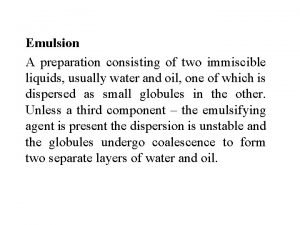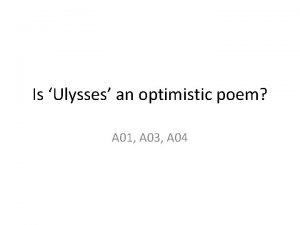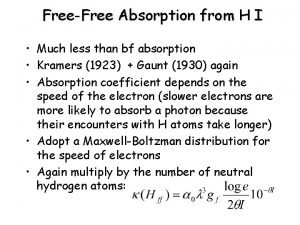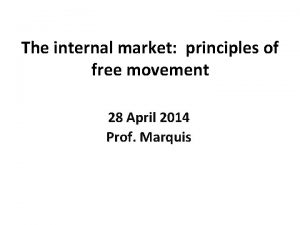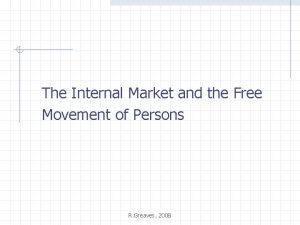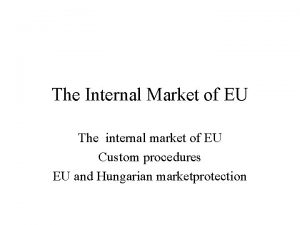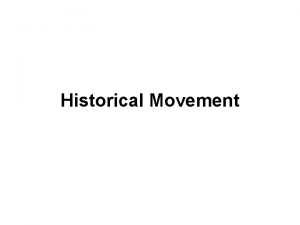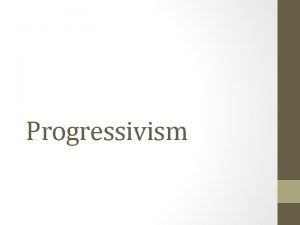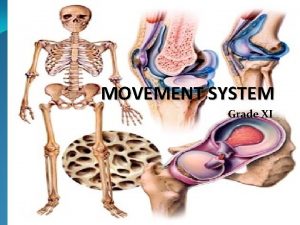The internal market principles of free movement 28





































- Slides: 37

The internal market: principles of free movement 28 April 2014 Prof. Marquis

Outline • Today: • I. Introduction » t • II. A. Non-tariff barriers (NTBs) to trade between Member States: The legal framework • Tomorrow: • II. B. NTBs to trade between MS: The classical case law » t • III. The outer limits of Art. 34

I. Introduction

• Free movement of: – Goods – Services – (Freedom of) Establishment – Persons – Capital • Case study: free movement of goods

• 1. ‘Positive’ integration » t – EU legislator adopts legislation (often on the basis of Art. 114 TFEU) » t – that provides (typically) for a minimum of harmonization to alleviate or remove barriers to trade between Member States » t • Such barriers may result simply from the fact that regulatory rules can vary from MS to MS » t – MS can go further if they so choose » • Poi … t

• 2. Negative integration: case-by-case removal or “disapplication” of trade barriers – Here the courts are the primary actors, presiding over litigation – Individual plaintiffs or the European Commission can initiate legal actions against the MS – The courts then invalidate (where they have that power) or “disapply” national rules that are contrary to the rules on free movement

Free trade as envisaged by the Treaty • The Treaty sets out the following tasks for the Union: To prohibit, as between MS, – 1. Customs duties (i. e. , duties on imports or exports); – 2. Charges having an equivalent effect i. e. , equivalent to customs duties); – 3. Quantitative restrictions (i. e. , quotas or bans on imports or exports); and – 4. Measures having an equivalent effect to quantitative restrictions) • Some exceptions apply, as we’ll see

II. Non-tariff barriers to trade between Member States A. The legal framework; and B. Introduction to the classical case law

A. The legal framework

• Article 34 TFEU provides: » t – “Quantitative restrictions on imports and all measures having equivalent effect shall be prohibited between Member States” » t • Art. 35 lays down a parallel rule in the case of quantitative restrictions on exports and measures of equivalent effect » t • Arts 34 and 35 thus aim at the most important source of NTBs: State measures that form or produce barriers to cross-border trade

BUT NTBs are not per se illegal

• MS can mantain QRs & MEQRs where this is justified by the public interest • Art. 36 TFEU: restrictions justified on grounds of: – Public morality / Public policy / Public security – Protection of industrial and commercial property – Protection of health and life of humans, etc. • (Case law exands the possible justifications under certain conditions)

• So there are two types of derogations » t – Art. 36 – mandatory requirements » t • But these are exceptions to a fundamental rule • Consequently, they are to be interpreted strictly » t • Four important consequences … » t • 1. Burden of proof on the MS to show that a derogation applies

• 2. If the measure is ‘distinctly applicable’, only the justifications listed in Art. 36 can be invoked – … Other goals, like environmental protection or consumer protection, are excluded in that case – may only be invoked as ‘mandatory requirements’ » t • 3. In all cases, purely economic justifications are rejected » t • 4. Proportionality test always applies

Principles of free movement: II. B. (Non-tariff) Barriers to trade between MS: Introduction to the classical case law 29 April 2014 Prof. Marquis

Today’s subject: alcohol 1. Whiskey 2. Liqueurs 3. Beer (and coffee)

Dassonville (1974)

• The Dassonvilles imported whisky from France into Belgium without a certificate of origin from the UK customs authorities • Belgian P. M. brought criminal charges. Defense based on Art. 34 • Did the Belgian rule on certificates of origin apply to all traders, foreign and domestic? » t – Yes: all importers, including Belgian importers, had to have a Certificate if they wanted to re-sell » t – so: it was not directly discriminatory (not ‘distinctly applicable’) • Was it discriminatory in an indirect sense?

• One might take the view that there was not a strong argument that the rule was even indirectly discriminatory » T • But the ECJ did not hesitate to conclude that the Belgian rule was within the scope of Art. 34… » t • The Court held that: – All rules enacted by MS which are capable of hindering, directly or indirectly, actually or potentially, trade between MS, are to be considered measures with effects equivalent to quantitative restrictions

The next step was the Court’s judgment in Cassis de Dijon (1979) Here the Court does two things 1. Introduced the concept of mutual recognition But also 2. introduced the concept of mandatory requirements

Cassis de Dijon (1979) • Contested measure was a German rule regulating fruit liqueurs » t • Minimum alcohol content: 25% – Not discriminatory on its face (‘indistinctly applicable’) • The problem: French Cassis de Dijon only contained 15 -20% alcohol » t • This regulatory diversity had the effect of a de facto ban on Cassis, a French product

• ECJ held: – Absent EU rules, obstacles to movement in the Community resulting from disparities between national rules on the marketing of products must be accepted if those provisions are necessary to satisfy mandatory requirements » t – such as public health, commercial fairness or the defence of the consumer, etc. » t • But: proportionality and less restrictive means

• a contrario, where mandatory requirements do not need to be protected: – if a product is lawfully produced/marketed in one MS, it must also be free to circulate in all MS • This is the “country of origin” principle, or the principle of “mutual recognition” – A de-regulatory rule; and controversial – But again: only where the M. R. doctrine fails

• How was Cassis resolved? Germany made two arguments. First, the rule protected public health » t • It prevented a proliferation of weak alcoholic drinks on the national market – Germany: weak drinks are more liable to induce tolerance – ECJ rejected this for lack of consistency » t • Germany also argued that the minimum alcohol rule protected consumers against unfair commercial practices …

• Consumers buying Cassis would think they’re getting the same alcohol content at a lower price • Meanwhile, German producers would be disadvantaged because alcohol is a costly input compared to the other ingredients, due its high tax rate • This argument failed the “least restrictive alternative” test – If Germany really wanted to protect consumers who might be confused about alcohol levels, it could do this by imposing label requirements

Expansion of possible mandatory requirements • Protection of the effectiveness of financial supervision • Protection of the environment • Protection adequate working conditions (e. g. , prohibition on night-time work in the baking industry) • Protection of cinema as cultural expression • Maintenance of press diversity • Protection against the risk of a serious financial imbalance jeopardizing the social security system • Protection of fundamental rights (freedom of speech, assembly, etc. ) • Et cetera…. open-ended category….

Breve riassunto of Dassonville and Cassis de Dijon 3 points

• 1. General rules • a. The prohibition of MS measures that restrict the FMG casts a wide net • All rules capable of hindering (directly or indirectly, actually or potentially) trade between MS are MEQRs under Art. 34 » t • b. Mutual recognition – If a good is marketed within the country of export in conformity with the regulations of that country, then in principle the country of import may not prevent importation of the product merely on the ground that its own rules and regulations are different or more stringent

• 2. Derogations are available • First, Art. 34 does not apply to measures justified by mandatory requirements » t • Second, Art. 36 provides an explicit derogation » t • But both types of derogations are limited: » t – Must be proportional. Restriction must in fact advance the relevant public interest objective; and there must be no less restrictive alternatives

III. The outer limits of Article 34

• After Dassonville and Cassis de Dijon, there was a large wave of litigation » t • A prominent objection to the case law was that common restrictions on the time, place and manner of sales were under attack – Example: if Italian rule says parucchieri cannot operate on Mondays, this may limit the sales of French shampoo in those shops – Would Dassonville apply? Yes: “All trading rules…” – But is that the purpose of Art. 34, or is that too radical?

• So how did the ECJ respond? – A rather dramatic adjustment in Keck and Mithouard (1993)

Keck and Mithuouard (1993) • Keck and Mithouard sold coffee and beer in France at a retail price below the wholesale price » t • French law prohibited re-sale at a loss » t • So: French authorities brought criminal charges against K & M … • Defendants invoked Art. 34 …

• ECJ: – In view of the increasing tendency of traders to invoke Art. 34 as a means of challenging any rules whose effect is to limit their commercial freedom, even where such rules are not aimed at products from other MS, it is necessary to re-examine the Court’s case law on this matter » t • Did not entirely overturn Dassonville and Cassis, but it introduced a new distinction between rules concerning “product requirements” and what it called “certain selling arrangements” (modalités de vente)

• 1. Product requirements – e. g. , form, size, weight, composition, presentation, labeling, or packaging – With regard to product requirements, nothing changes: the prior case law applies just as before • 2. Certain selling arrangements – ECJ: Contrary to what has previously been decided, national rules that do not regulate trade but restrict certain selling arrangements do not hinder trade between MS within the meaning of Dassonville if two conditions are satisfied…

• a. the national provisions must apply to all affected traders operating in the territory; and » t • b. the provisions must be non-discriminatory in law and in fact » t • ECJ: if those conditions are satisfied, then the restrictions do not impede market access foreign goods any more than they do for domestic goods

• … and Commission v Italy: Non-discriminatory ban on mopeds, motorcycles, etc. towing a trailer on Italy roads » t • ECJ: – Measures which have the object or effect of treating products from other MS less favorably are MEQRs within the meaning of Article 28 – Any other measure which hinders access of products originating in other MS is also covered by that concept
 Market follower
Market follower Segmentation targeting positioning analysis
Segmentation targeting positioning analysis Light gun signals
Light gun signals What are the 7 axial movements
What are the 7 axial movements Continental gum method
Continental gum method Theories of emulsion
Theories of emulsion Explain the concept of internal control
Explain the concept of internal control Audit report of a company
Audit report of a company How do biomechanical principles influence movement
How do biomechanical principles influence movement Principles of art movement
Principles of art movement Passive movment
Passive movment Centre of gravity pdhpe
Centre of gravity pdhpe Gibbs free energy spontaneous
Gibbs free energy spontaneous Unit of entropy
Unit of entropy Gibbs free energy equation
Gibbs free energy equation The allocation map
The allocation map Helmholtz free energy and gibbs free energy
Helmholtz free energy and gibbs free energy Optimistic poem
Optimistic poem Free body and soul free
Free body and soul free Free-free absorption
Free-free absorption Hình ảnh bộ gõ cơ thể búng tay
Hình ảnh bộ gõ cơ thể búng tay Frameset trong html5
Frameset trong html5 Bổ thể
Bổ thể Tỉ lệ cơ thể trẻ em
Tỉ lệ cơ thể trẻ em Gấu đi như thế nào
Gấu đi như thế nào Chụp tư thế worms-breton
Chụp tư thế worms-breton Bài hát chúa yêu trần thế alleluia
Bài hát chúa yêu trần thế alleluia Các môn thể thao bắt đầu bằng tiếng chạy
Các môn thể thao bắt đầu bằng tiếng chạy Thế nào là hệ số cao nhất
Thế nào là hệ số cao nhất Các châu lục và đại dương trên thế giới
Các châu lục và đại dương trên thế giới Công thức tính thế năng
Công thức tính thế năng Trời xanh đây là của chúng ta thể thơ
Trời xanh đây là của chúng ta thể thơ Mật thư anh em như thể tay chân
Mật thư anh em như thể tay chân Phép trừ bù
Phép trừ bù độ dài liên kết
độ dài liên kết Các châu lục và đại dương trên thế giới
Các châu lục và đại dương trên thế giới Thể thơ truyền thống
Thể thơ truyền thống Quá trình desamine hóa có thể tạo ra
Quá trình desamine hóa có thể tạo ra





